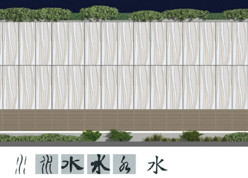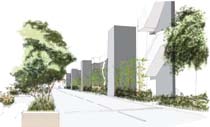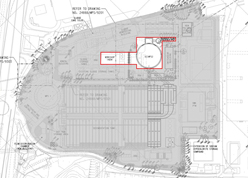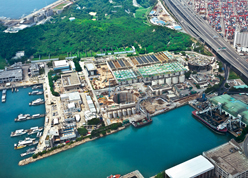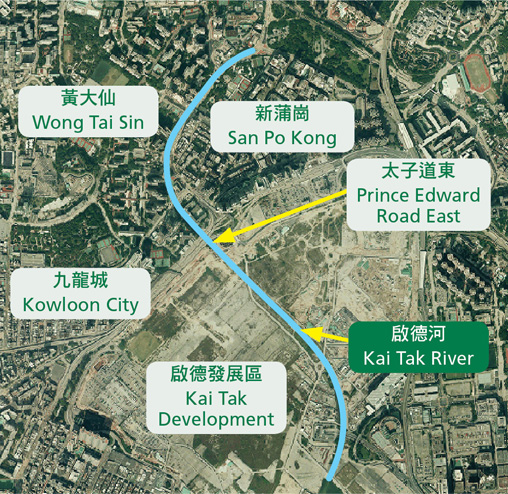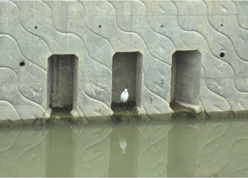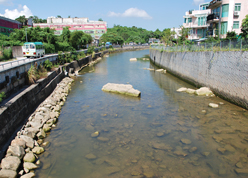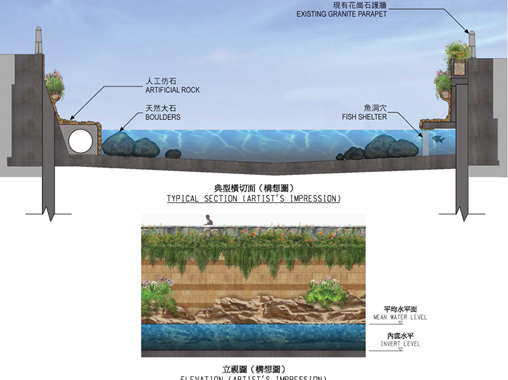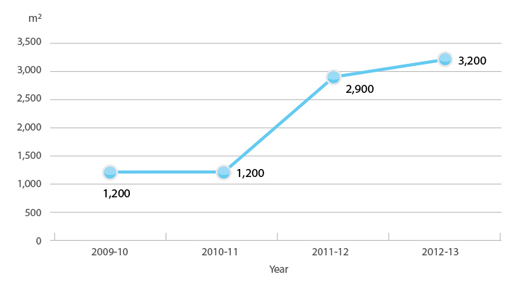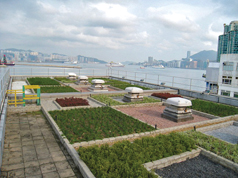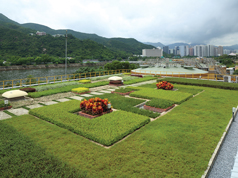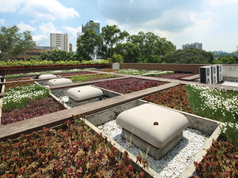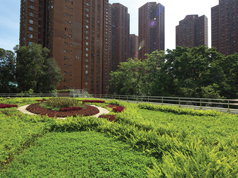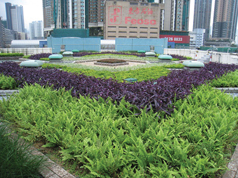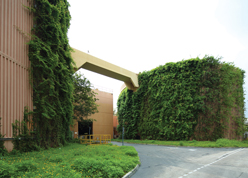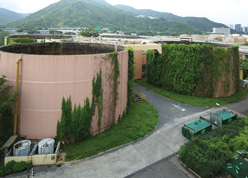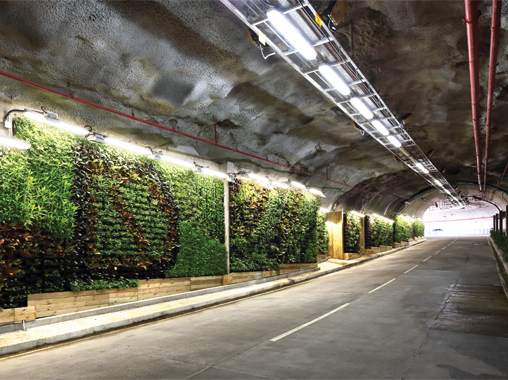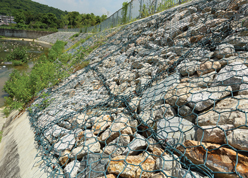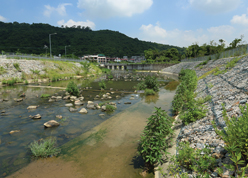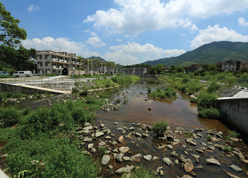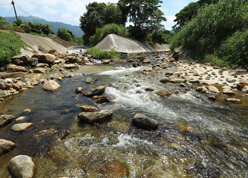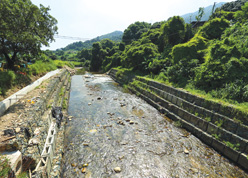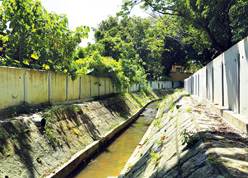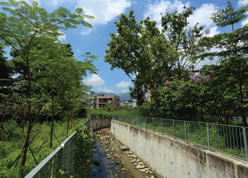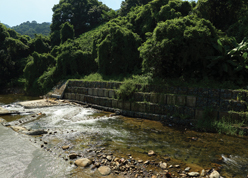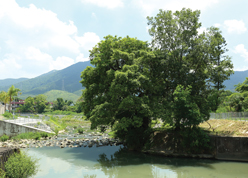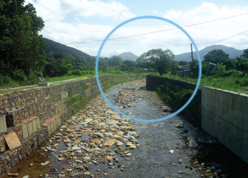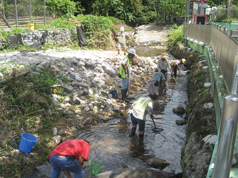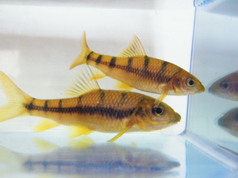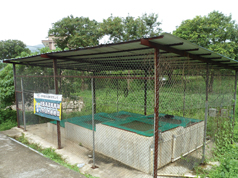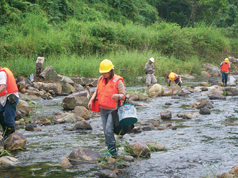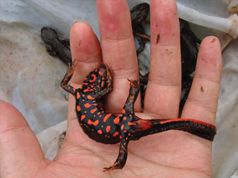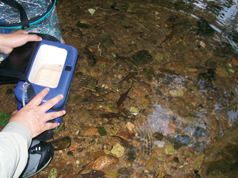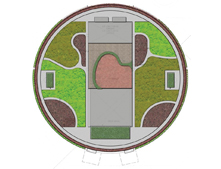Greening and Conserving Ecology
Upcoming Greening and Beautification Works in Stonecutters Island Sewage Treatment Works under HATS 2A
Stonecutters Island Sewage Treatment Works (SCISTW) is in a prominent location close to western Kowloon. It is overlooked by the public from the high rise developments around Lai Chi Kok and Tai Kok Tsui from its North and East. The Southwest of the site is screened by a lushly vegetated woodland. Environmental improvement works have been introduced to reduce the visual impact of the site as follows.
Elevation treatments
The elevation treatment consists of three main features, namely synthetic timber cladding, green vegetation at ground and roof levels, and a signature series of tricolor Shanghai render modular panels reflecting the ancient Chinese pictogram for water, which improve the appearance of the buildings.
Soft landscaping along site roads and roofs to strengthen the greening effect
Site roads will be enhanced by the introduction of local plant species in a combination of planting boxes and beds next to the existing tanks. Roofs will be turned into a series of vividly green landscapes with a mixture of shrubs, groundcover plants and gravelled paths.
Covering of the sedimentation tanks with randomly coloured pattern
The sedimentation tanks have been covered with a random pattern of multi-coloured units which enhances the appearance of the tanks and forms part of the odour control treatment system.
In addition, a BEAM (Building Environmental Assessment Method) Plus assessment is being carried out for a designated area of the SCISTW site in order to demonstrate our commitment to sustainability. The assessment covers the new workshop and the new main pumping station building. BEAM Plus provides building users with a single performance label that demonstrates the overall quality of a building. To demonstrate our commitment in protecting the environment, we are planning to implement number of enhancements of building performance through the current construction contracts. The enhancement works include the provision of refuse recycling rooms, use of glasscrete as porous pavement, reuse of demolition waste, addition of solar panels and use of LED lighting for energy saving, use of WC split-tanks for water conservation, and addition of intake ventilation-fans for improving indoor air quality.
Proposed Greening and Ecological Conservation Works in Kai Tak River Improvement Works
Kai Tak River is one of the major drainage channels in East Kowloon. It originates from Po Kong Village Road at Wong Tai Sin, flows parallel to Choi Hung Road and Tung Kwong Road adjacent to Tung Tau Estate and Tung Wui Estate, runs underneath Prince Edward Road East before traversing the Kai Tak Development (KTD) area and finally discharges into Victoria Harbour. The total length of Kai Tak River is about 2.4 kilometres. It was built in tandem with the former Kai Tak Airport some decades ago and found inadequate to meet the current flood protection standard. Flooding incidents have occurred along Choi Hung Road during heavy rainstorms and severely affected the traffic of Wong Tai Sin and its adjacent districts.The Kai Tak River Improvement Works are being implemented , which aim to improve its drainage capacity and mitigate flooding risk to the surrounding areas.
To engage the public on the planning of Kai Tak River, we conducted a two-stage public engagement exercise on "Building our Kai Tak River" in 2010 and 2011. According to the engagement results, there are strong public aspirations for revitalising Kai Tak River into an attractive green river and townscape feature to enhance its visual quality and image, in addition to its prime objective for flood protection. To meet such aspirations, we have incorporated various landscape, greening and ecological elements in the Kai Tak River Improvement Works with a view to rehabilitating the Kai Tak River into a green river corridor in urban areas. Greening works include installation of planters and artificial rock along the river walls. Selected species of submerged plants will also be cultivated at river bed to foster a natural environment. The existing granite parapets along the river walls will be retained in general for heritage conservation purpose. Though the ecological value of the existing riparian habitat is relatively low, we will introduce fish shelters and boulders on river bed to enhance the microhabitat and species diversity. These have been proven successful in the river improvement works at Ho Chung River in Sai Kung.
Kai Tak River Improvement Works are being carried out in stages. We have commenced the construction works for Kai Tak River's upstream (from Po Kong Village Road to Tung Kwong Road) since October 2011 for completion in 2017. We have also planned to commence the construction works for the midstream (from Tung Kwong Road to Prince Edward Road East) in end of 2013. The Civil Engineering and Development Department has commenced the downstream upgrading works within KTD in early 2013 for completion in 2018.
In-stream refugia are provided at Ho Chung River for providing shelters for fishes, invertebrates and other aquatic animals when the flow at the River is fast
Overall Greening Works in DSD Facilities
In 2012-13, our Department continued to make all efforts in carrying out greening works in various projects, including the incorporation of green roofs in new projects and existing facilities. During the year, we planted more than 3,300 trees and 560,000 shrubs, and provided an additional 3,200 square metres of green roofs in various facilities.
Area of Green Roof Added
The most recent examples of completed green roofs in 2012 were Tai Yuen Sewage Pumping Station (SPS), Cheung Sha Wan SPS, Waterboat Dock SPS and To Kwa Wan Preliminary Treatment Works (PTW). These green roofs not only help create a pleasant environment, but also lower the building temperature and alleviate the heat island effect during summer.
Vertical Greening in DSD Facilities and related Research and Development Work
Our Department has collaborated with the University of Hong Kong since June 2009 to carry out a vertical greening study on the external walls of four sludge storage tanks at Shatin Sewage Treatment Works (STSTW). The objective is to study the greening effects of different climber species and their effects on temperature reduction. The study was successfully completed in March 2013 and the result revealed that the temperature of exterior green wall with vegetation cover could drop by seven degree Celsius in summers. The study received the Merit Award under Landscape Planning/Research Category of "Landscape Design Awards 2012" organised by the Hong Kong Institute of Landscape Architects.
20 climber species of two different climbing modes i.e. trailing plants in mesh mode (mesh climbers) and self-climbing plants in concrete mode (concrete climbers) were systematically assessed in the study. The overall result shows that the greening effects of the tested mesh climbers and concrete climbers are very promising. With 30 months of growth monitoring, the growing characteristics and performances of the 20 climber species were recorded and will provide a good reference in our future projects. We will encourage project officers to introduce mesh climbers and concrete climbers in new projects and retrofit existing facilities, as they are simple for installation, easy to maintain, with low initial set up cost and good greening effect.
Apart from these two climbing modes, we have also explored the opportunity of indoor vertical greening using proprietary vertical greening (VG) systems. A trial planting of over 60 metres long indoor vertical green wall with five different VG systems was installed at our cavern facility, the Stanley STW, in January 2013. We will conduct research with the Chinese University of Hong Kong to study the performance and cost-effectiveness of these VG systems. The research is expected to be completed by 2014.
Greening Works and Ecological Conservation Measures at Tai Po
The drainage improvement works at Tai Po not only alleviate the local flooding risk but also make valuable contribution to the local greening efforts. To preserve the ecological values of existing rivers, our engineers have integrated various environmentally friendly elements into our drainage facilities, which are outlined below.
Simulation of Existing River Characteristics
To alleviate the local flooding risk, the existing rivers at Tai Po have been trained for enhancing their drainage capacity. The banks of the widened rivers were paved with rockfill mattresses/gabion units or grasscrete aiming to simulate the riparian environment in existing rivers.
Some of the existing river stream beds were of stony substratum. After river training works, we put rip-rap at the bottom to mimic the profile of a natural stream course. This was to facilitate the re-colonisation of the stream after completion of the drainage improvement works. Instead of placing single-sized rip-rap at channel base, both boulders and cobbles of varied dimensions were laid to form series of pools and riffles for creation of favorable habitats for both adult and juvenile local fish species.
Retaining the Existing River Bed
For drainage improvement works in areas with lower risk of flooding, we chose to construct flood protection walls at both sides of the stream instead of conducting deepening and widening works for the streams. This will preserve the existing natural stream bed so that the ecology in the existing stream could be preserved. When condition warrants, a particular section of the existing river would be retained for preserving the habitat and minimising disturbance to the natural environment arising from the works.
Planting along River Channel
Our engineers and landscape architects have contributed to the establishment of riparian vegetation in local areas by cultivating selected plant species along both sides of the river to enhance its visual appeal and biodiversity. We have also protected and preserved the existing trees and vegetation to minimise disturbance to natural environment.
Protection of Existing Ecological System at Kau Lung Hang
A rare species of freshwater fish, Acrossocheilus parallens, was identified in the streams at Kau Lung Hang during our works. To preserve this important species, we have constructed a set of fish holding tanks at the upstream for temporary accommodation of the Acrossocheilus parallens before commencing the drainage improvement works. With the completion of river channels and re-creation of suitable habitats, we will translocate the Acrossocheilus parallens from the temporary tanks back to the engineered river channels for re-colonisation.
Acrossocheilus parallens is distinguished by the presence of a dark lateral stripe and 6 to 7 short blackish vertical stripes
Protection of Existing Ecological System at Lam Tsuen Valley
Lam Tsuen River is the home of a protected freshwater amphibian species namely Paramesotriton hongkongensis. To preserve this valuable ecological resource, we have relocated the species to the upstream of the stream course within the construction site prior to the commencement of the river improvement works and before we resume works at the beginning of each dry season. Once captured, the species were immediately released at the river upstream of the construction site.








